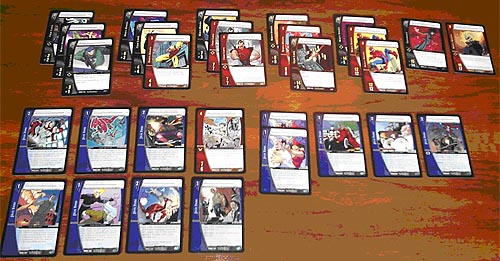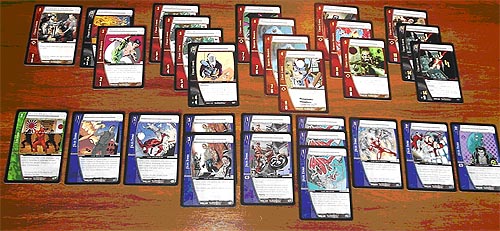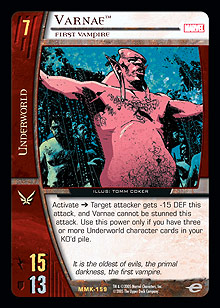
Yes, you read that right. Here is the first article by the German leader of Operation: Zero Tolerance on Metagame.com. And it’s not even about purple robots, but Booster Drafting!
Drafting is a format not easily mastered nowadays, as I learned in Amsterdam when incorrect metagame anticipations put me out of contention early. That was a hard lesson to learn, as I had made Day 2 at PC Los Angeles (playing Teen Titans) even though I had only been playing this great game for a few weeks then. We were the only three Germans in Anaheim (Andre Müller and Kristian Kockott came with me), and I am happy to have since motivated some more players to play the Pro Circuit and stay at my place for testing the week before an event. So be prepared to find more than one “umlaut” in future Top 8 lists.
Despite a lot of testing, it seemed impossible to build a deck that could handle Sentinels’ combat dominance, Teen Titans’ tricks, and Fantastic Fun’s burn engine. So we stayed with Sentinels, as most teams did. That allowed five of the eight german players to draft on Day 2.
Green Lantern was released later in Europe than in the United States, and the prereleases had to be skipped in favor of $10K Paris. This left us without much drafting experience with the new set. I mispicked several times and ended up short on expensive characters, but somehow I still managed to go 2-1 with the deck and have a lot of fun. The best thing was when I managed to decimate Jason Hager’s board on turn 7, putting him in a nearly hopeless position until he recruited Appa Ali Apsa on turn 8. I played another three small characters, exhausted eight characters for Katma Tui (gaining 20 endurance), and then KO’d eight characters for Evil Star’s ability to KO Appa Ali Apsa. That put the endurance totals at 49 to -4 in my favor.
Because there is still a lot for me to learn about Green Lantern drafting and because my draft already got covered in the event coverage, I will just give a picture of my deck and then go more into detail on my Marvel Knights drafts. The deck would have been great with an additional 5-, 6-, and 7-drop instead of all those 2-drops, but the plot twists and willpower-based synergies were fine.
So then came the Marvel Knights drafts where everybody was expected to know exactly what to draft, whereas the Green Lantern set had yet to be explored.
I do not like the way the plot twists work in Marvel Knights because they force you into specific team affiliations earlier than in other sets. If a set’s plot twists are not team-stamped, you can use your first picks on those plot twists while looking at the characters that will get around the table and deciding your teams later on. As you will have to play ten of the fourteen cards from each pack, wasting your first picks on cards that end up in the side deck really hurts your main deck. Therefore, you normally stay with the team(s) you decided upon in the first pack. With the team-stamped plot twists, you have very few picks before you have to commit to a team by picking either a character or a plot twist, and after that, you have to start praying that your neighbors did not choose the same affiliations.
During the Marvel Knights drafts at Pro Circuit New York, I tried to pick the generic plot twists as long as possible, passing better team-stamped cards to keep flexible for signals from my right neighbor. This hurt Ryan Jones, sitting to my left in the final draft, quite a bit. He took Wild Ride, Punisher’s Armory, and Spider-Man, The Spectacular Spider-Man as signals to draft Marvel Knights, while I had chosen cards like Blown to Pieces and Marvel Team-Up to keep undecided but also ended up with Marvel Knights cards. So he had to suffer what I feared the most¾being cut off from the team you chose early.
Using this draft style, I was able to draft two decent decks based on the same teams (Marvel Knights and Crime Lords), although their routes to victory were quite different. While the first one was a concealed deck focussing on board control by using tricks that KO’d characters, the second one was mainly Crime Lords with big visble characters who jumped the curve on the offense and stunned every attacker back on defense.

I like to have a theme in my drafts and multiples of the cards that are important to that theme. If you manage to draft a theme, your deck performs more consistently by doing the same tricks every match. As long as the theme is strong, that is what you want to happen. With just two cards with equal function, you will have the same consistency as you would when playing four copies of a card in Constructed.
In the first MMK draft, the most important cards were the two Quick Kills, Judge, Jury, and Executioner, and Deposed. Those cards are not very high picks, but if you have them in multiples, they shine. They were also a natural fit for my many concealed characters, which normally are a disadvantage in Booster Draft. I was about 20 endurance behind in the race most of the time, but when my opponent’s board was cleared, my character advantage brought me the game.

My final draft deck at the first table was simply brutal. The smile on my face when I left the table could probably have been used in a toothpaste commercial. Crime Lords was very under-drafted, so I got all the good tricks. I added the best Marvel Knights characters to improve my Moving Targets and enable Elektra, Agent of the Hand. Elektra with boost is the best aggressive 6-drop in this format and a nice follow-up after Moon Knight and Jigsaw.
The standard number of turns a draft game takes is seven, so you want the odd initiative most of the time and about two 7-drops in your deck. Having only one real 6-drop (not even a good one) and no 7-drops at all seems to be a bad idea at first glance, but the Moon Knights and Elektras smooth out the curve by counting as 4- or 5- and 6-drops.
 But what can be done on turn 7? There should not be a turn 7 with this deck! Drafting an aggressive deck that normally wins on turn 6 has multiple advantages: You do not need to waste high picks and deck slots on 7-drops and you do not need to win the die roll to get your initiative of choice, as most players will correctly select the odd initiative if they win the die roll. Of course, you cannot head into the draft with the plan to pass on all the 7-drops, but you can adjust your plan in the middle of the draft to that strategy. That is also true for the other direction. If you get an early Varnae, First Vampire and Spider-Man, you can start looking for Ghost Rider, Danny Ketch and Gravesites to search for those cards and set up a perfect late game, choose the even initiative, and win on turn 8. Knowing the cards’ strength is only the first step, while reevaluating pick orders by taking your drafted cards into account and putting a good theme together is the next skill to master.
But what can be done on turn 7? There should not be a turn 7 with this deck! Drafting an aggressive deck that normally wins on turn 6 has multiple advantages: You do not need to waste high picks and deck slots on 7-drops and you do not need to win the die roll to get your initiative of choice, as most players will correctly select the odd initiative if they win the die roll. Of course, you cannot head into the draft with the plan to pass on all the 7-drops, but you can adjust your plan in the middle of the draft to that strategy. That is also true for the other direction. If you get an early Varnae, First Vampire and Spider-Man, you can start looking for Ghost Rider, Danny Ketch and Gravesites to search for those cards and set up a perfect late game, choose the even initiative, and win on turn 8. Knowing the cards’ strength is only the first step, while reevaluating pick orders by taking your drafted cards into account and putting a good theme together is the next skill to master.
What I like best about the deck is the plot twist theme I assembled here. Hand Dojo, Blown to Pieces, Uprising, Shakedown, Marked for Death, and Bring the Pain can all be used to ensure that every character daring to attack me will be stunned back by my defenders. Therefore, I can try to get character advantage during my initiative while keeping things equal during my opponent’s initiative. Once my opponent starts attacking across (attacking up and down never works out because of the many Nasty Surprises), I can try to wreck his or her plans with my Moving Targets.
I hope you enjoyed my article or even learned something new! Thanks to everybody who helps to make the Pro Circuit so much fun, and especially to my team for helping me to compete with the best!
See you at PC Indy,
HaJo